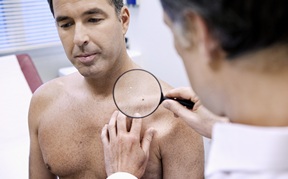Skin cancer usually appears in areas of skin that are frequently exposed to sunlight, such as the face, neck, hands, and arms, but it is important to remember that it can occur anywhere on the body, even on the footsteps.
There are few types of cancer that start in the skin. Nonmelanoma skin cancers, such as basal cell carcinoma and squamous cell carcinoma, are most prevalent and seldom spread to other parts of the body. Melanoma, the deadliest type of skin cancer, could give metastases if a patient does not receive adequate and timely treatment.
Early treatment significantly improves the chance of recovery, that’s why it is essential to visit a dermatologist immediately after you’ve noticed any suspicious visual changes on your skin.
If you live in Bradenton or Lakewood Ranch areas, you can contact us and schedule a complete and thorough evaluation at one of our 3 locations.
Treatment and diagnostic options available at Arsenault Dermatology
Tools for skin cancer prevention and early detection
At Arsenault Dermatology, you can pass your annual total skin examination aimed to ensure that you have no abnormal growths, or schedule an urgent consultation in case anything on your skin looks suspicious to you or your family doctor.
The experienced providers at Arsenault Dermatology use a dermatoscope, a handheld device which greatly magnifies the skin, allowing us to detect the development of unusual growths or spots naked to the human eye.
We also offer digital mole mapping service – an innovative procedure that allows to track and store photographic information about moles on different areas of your skin: their location, amount, color and size. This information is stored on Arsenault Dermatology’s HIPAA-compliant secure server with your medical records.
In addition to these services, we pay close attention to educating all of our patients on skin cancer risk factors and preventative measures.
Diagnostics
In case our doctors find abnormal-looking lesions, they perform a skin biopsy (a cut of the whole lesion or its part) and send the obtained specimen to the laboratory for histopathological examination.
Skin cancer treatment options
We perform different types of skin cancer treatment depending on the patients’ age, diagnosis, overall health status and preferences (if it’s possible).
Mohs MIcrographic Surgery
A type of skin cancer surgery when histopathological examination of a malignant lesion is performed during the operation. The excised tissue is sectioned, frozen, stained, mapped in detail, and then examined under a microscope, while a patient stays at doctor’s office. If cancer is still present in the depths or peripheries of the excised tissue, the procedure is repeated until the last layer viewed under the microscope is free from cancerous cells. Mohs surgery allows to spare more healthy tissue, decreases the rate of local recurrence, and provides high cure rates. It is indicated for tumors that have recurred, are poorly differentiated, or appeared in the areas with thin skin, or those that are aesthetically and functionally important. The cosmetic outcome of Mohs surgery is usually good.
Excisional Surgery
The dermatologist removes the entire growth along with an enclosing border of healthy skin as a safety margin. The wound in surgical site is then closed with sutures. After the surgery, the excised tissue is sent to a laboratory for microscopic examination to confirm that all cancerous cells have been eliminated.
Cryosurgery
The dermatologist destroys the tumor by freezing it with liquid nitrogen. There is no cutting or bleeding, and usually, no anesthesia is needed. The treatment may be repeated several times during the same session until all malignant cells are destroyed. The treated area becomes crusted and scabbed and normally falls off within weeks.
Photodynamic Therapy
During the photodynamic therapy, the treated area of the skin is saturated with a chemical that makes it more sensitive to a specific type of light emitted from an equipment at a dermatologist’s office. Then this area is exposed to this light, destructing the cancerous and precancerous lesions in this way.
Topical Medication
Topical medications are prescribed according to patient’s diagnosis, individual characteristics, and treatment method.

